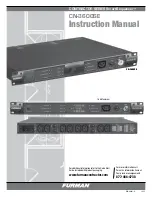
GE Power Management
ALPS Advanced Line Protection System
4-3
4 ACCEPTANCE/PERIODIC TESTS
4.1 OVERVIEW
4
In tests that cause tripping, the trip target type may not match the unit being tested in the procedure. For example, if a
Zone 1 ground fault is being tested, Zone 2 may pick up and trip the relay before the fault is in Zone 1's characteristic.
The target information will reflect the Zone 2 trip, not Zone 1. Keep this in mind during the tests.
Use a continuity tester with high input impedance, such as a digital ohmmeter, to monitor the A1 contact during relay
testing.
Tripping contacts operate while the relay is in test mode unless the outputs are disabled.
2.
Where appropriate, current levels are defined with two numbers as
xx(yy); xx is the value to be used for relays rated at
5 amperes and (
yy) is the value to be used for 1 ampere relays.
3.
One or more of the electronic current sources may not be used during a test. If the source is not used, it must be set to
zero, in addition to being disabled. Also, the currents should always be set at or near zero whenever a current source
is powered on or off.
4.
The phase angles of the test sources are shown relative to phase A voltage. A positive phase angle indicates the ref-
erenced quantity is leading phase A voltage. A negative phase angle indicates the referenced quantity is lagging
phase A voltage.
5.
All test voltages are phase-to-ground measurements unless otherwise specified.
6.
Entries at the keypad are shown as KEY, with the label of the key to be pressed. For tests that require a setting
change, the setting number is shown in parentheses next to the setting. This is performed by pressing the SET key,
choosing the setting type (Protection or General), the group (if necessary), the setting number (
nnnn), and [ENT]. The
new setting may then be entered.
Operation of Potential Transformer Fuse Failure (PTFF) will cause the Critical Alarm to operate.
7.
When testing the relay using the ALPS-Link software, the only time that information will automatically appear on the
display is after the relay has tripped or to report a detected error. Relay status and test mode information will not
appear.
8.
At the end of testing, make sure that all settings are returned to their initial values. This can be done through the ALPS-
Link by uploading the settings to the PC before testing begins and then downloading them back to the relay when test-
ing has been completed. If a PC is not available, scroll through all settings using the keypad and verify each one with
the settings table in Chapter 2: CALCULATION OF SETTINGS.
4.1.7 SETTING CHANGES
Setting changes required for a particular test are listed before the test. A sample setting change is shown below. Refer to
Chapter 8: LOCAL USER INTERFACE for further details on making setting changes.
a) EXAMPLE SETTING CHANGE
This example illustrates changing the reach of the Zone 1 Ground Unit to 5.6 Ohms.
1.
Apply rated DC and wait for relay initialization to complete, indicated by a solid green status LED on the front of the
relay.
2.
Press the SET key. The message Enter Password is displayed. If this is the first time the Settings Level functions are
used, the password has the factory value “123.”. This password must be changed before any setting functions can be
accessed. See Chapter 8: LOCAL USER INTERFACE for details on changing the password.
3.
Enter the current settings level password. If the password is not known, see Chapter 8: LOCAL USER INTERFACE for
details on viewing the password. When the correct password is entered, the settings menu is displayed.
4.
Press the [1/Y] and [ENT] keys to select Protection settings.
5.
Scroll with the arrow key until the cursor is on 1. Z1DISTANCE then press the [ENT] key.
6.
Scroll through the Z1DISTANCE menu until Z1GRDREACH = #.# appears on the display.
7.
Press the [ENT] key and then enter “5.6” on the keypad. The inputs appear on the display and the equals sign (=)
changes to a blinking colon (:) to indicate that a change has been made but not yet entered.
NOTE
NOTE











































